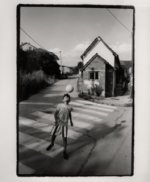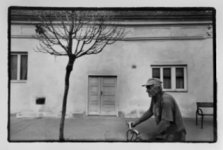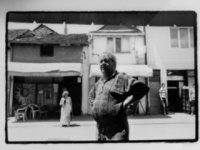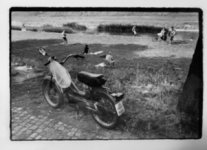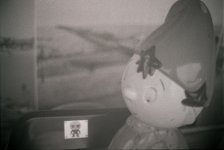Like some others here, I've long held to the belief that it isn't so much the film/s, cameras or lens/es that produce the 'soft' vintage look, but rather how the film is developed.
Now and then when I feel especially masochistic, I do scanning of old negatives for friends, mostly fading/faded color negatives but now and then some very old B&W. What strikes me most about these old images is how contrasty they are.
The films of that era were often as not processed locally (in my home town in eastern Canada in th 1950s the local pharmacist had a makeshift darkroom in a closet of his medicines shop and processed and contact printed all the local snaps after closing time. Many years later after he had retired, he told me he used Kocak Tri-Chem packs for many years and occasionally when he was out of film developer he would make do with D-72. No surprise the contrast of all those negatives were through-the-ceiling contrasty...
Nowadays I process those few films I still shoot in my ageing cameras with a Job and I mostly scan. I've found after much experimenting that I get the best results by cutting development by 15% or even 20% to deal with the harsh Australian sunlight. My negatives do look slightly underexposed but they scan beautifully - lots of lovely silky greys in the mid tones and a pleasant pattern of light grain. I also use older films (am now working thru the last of a big batch of Kodak Panatomic-X 35 and 120 I bought in the early 1990s and have kept refrigerated but not frozen) which have aged with a slight gray tint which, so I'm told, actually helps to cut down contrast in scans.
Admittedly I wouldn't use certain films (Ilford Pan F for one) for my everyday photography, not so much for its legendary high contrast which I've found an be tamed by careful processing, but because I no longer want to stock up big time on films, at my age my shooting time is now very limited and I'm trying to not leave too much detritus behind for my partner to have to deal with when I'm no longer in this universe.
The two oldest cameras I own are 120 folders, (1) a Zeiss Nettar with an f80/4.5 Novar from about 1950 and (2) a Voigtlander Perkeo I with a wonderful 80/4.5 Color Skopar lens from about 1953. These two lenses are contrasty and I've worked out that with full exposure, even then my readings are all over the place anyway due to the age of both my films and my 1960s Gossen Lunasix, a 20% cut in developing time produces easily printed or scanned negatives as long as I shoot in sunlight.
Some of you may be interested that the softest lens I own and use is a Schneider Xenar on a 1960s Rolleicord Vb. The Zeiss lenses on my other Roles - two Tessars and a Planar - are higher-contrasty, especially the latter.
Ao much good and useful information in this thread I've bookmarked it for future reference.




